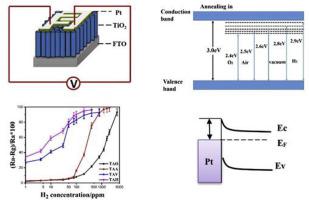International Journal of Hydrogen Energy ( IF 8.1 ) Pub Date : 2020-05-26 , DOI: 10.1016/j.ijhydene.2020.04.190 Huanhuan Zhang , Tiyue Tao , Xinlei Li , Yuwen Bao , Xiaohong Xia , Manon Lourenço , Kevin Homewood , Zhongbing Huang , Yun Gao

|
With the increasing usage of hydrogen energy, the requirements for hydrogen detection technology is increasingly crucial. In addition to bringing down the working temperature, further improvement in the response and broadening the detection range of hydrogen sensors in particular are still needed. TiO2 based sensors show great promise due to their stable physical and chemical properties as well as low cost and easy fabrication, but their detection range and low concentration response requires further improvement for practical applications. Here (002) oriented rutile TiO2 thin films are prepared by a hydrothermal method followed by annealing in either air, oxygen, vacuum or H2 and the hydrogen sensing performance are evaluated. Raman results show that TiO2 thin films annealed in vacuum and hydrogen have more oxygen vacancies, while those annealed in air and oxygen have a more stoichiometric surface. Annealing in an oxygen-rich atmosphere is shown to extend the detection range of the TiO2 sensors while annealing in anaerobic atmospheres increases their response. At high hydrogen concentrations surface adsorbed O2− is the dominant factor, while at low concentrations the Schottky barrier between Pt and TiO2 is key to achieving a high response. Here we show controlling the TiO2 surface properties is essential for optimizing hydrogen detection over specific concentration ranges. We demonstrate that adjusting the annealing conditions and ambient provides a simple method for tuning the performance of room temperature operating TiO2 based hydrogen sensors.
中文翻译:

通过表面缺陷工程扩展TiO 2基氢传感器的检测范围和响应
随着氢能使用的增加,对氢检测技术的要求越来越关键。除了降低工作温度之外,还特别需要进一步改善响应并扩大氢传感器的检测范围。基于TiO 2的传感器由于其稳定的物理和化学性质以及低成本和易于制造而显示出巨大的希望,但是其检测范围和低浓度响应需要针对实际应用进行进一步的改进。在此,通过水热法制备(002)取向的金红石型TiO 2薄膜,然后在空气,氧气,真空或H 2中进行退火,并评估氢感测性能。拉曼结果表明,TiO在真空和氢气中退火的2个薄膜具有更多的氧空位,而在空气和氧气中退火的薄膜具有更多的化学计量表面。在富氧气氛中进行退火可以扩大TiO 2传感器的检测范围,而在厌氧气氛中进行退火可以提高其响应速度。在高浓度的氢吸附表面ø 2 -是主导因素,而在低浓度下的Pt和TiO之间的肖特基势垒2的关键是实现高的响应。在这里我们展示了如何控制TiO 2表面性能对于优化特定浓度范围内的氢气检测至关重要。我们证明了调节退火条件和环境温度提供了一种简单的方法,可用于调节基于室温工作的TiO 2氢传感器的性能。











































 京公网安备 11010802027423号
京公网安备 11010802027423号